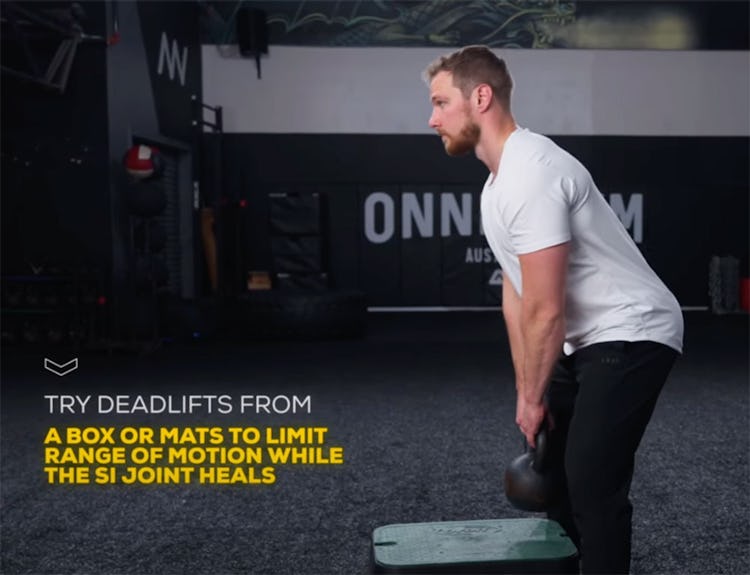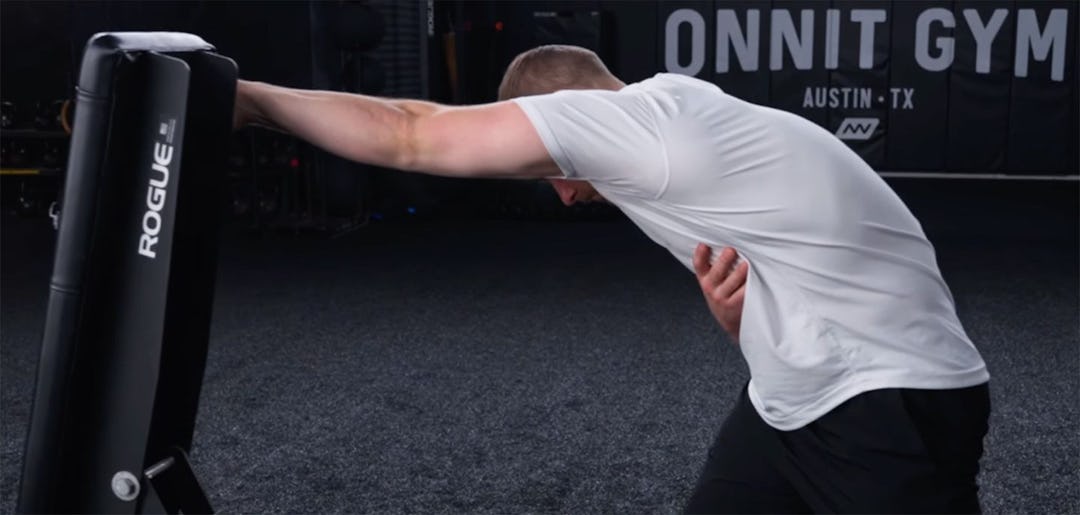Your lower back pain may stem from dysfunction in one or more of your sacroiliac (SI) joints. Fortunately, we rounded up some stretches and exercises that can bring fast relief.
What Is The SI Joint & Why Does It Hurt?
(See 00:24 in the video above)
The SI joints connect the bony part of the lower spine that’s just above the tailbone (called the sacrum) with the top of the pelvis (the ilium). They work to support the weight of the upper body when you’re standing and walking. Unlike the hip and shoulders, the SI joints aren’t designed to move very much, and pain can result when we force them to move more than they should. The most common causes of SI joint pain are limb-length discrepancies (one leg is longer than the other), abnormal walking patterns, scoliosis, and carrying a child while pregnant, but strain from heavy lifting can be a culprit too.
“With regard to working out, specifically, we tend to overdo movement in the sagittal plane,” says Layne Palm, DC, a chiropractor in Austin, TX, and a nationally-ranked Olympic weightlifter (@laynepalmdc). In other words, we favor exercises that have our limbs and torso moving forward and back, such as deadlifts, bench presses, and running. “Over time, this can overload the SI joints and cause compression that leads to irritation.” For the sake of avoiding future SI joint pain, Palm recommends performing more exercises that work the body in the frontal and transverse planes—that is, moving side to side and in rotation, respectively. Strengthening the body’s different movement capacities will take pressure off the SI joints.
Why Stretch Your Sacroiliac (SI) Joint & What Does It Do?
When suffering from SI joint pain, many people’s first instinct is to try to stretch the joint. Because they feel tightness in the area, they think stretching will release it. Palm cautions against doing this, as stretching an unstable joint can only exacerbate the problem (furthermore, it’s impractical to stretch the SI joint, specifically). The right move, he says, is to stretch the musculature that acts on the SI joint. These muscles include the hip flexors (the muscles that raise your leg in front of you), glutes, lats, and spinal erectors (the ones that hold your spine upright, and stand out on your lower back). “Stretching these muscles will often release the tension that is causing extra compression and uneven pressure on the SI joints,” says Palm.
3 Stretching Exercises To Loosen Your SI Joint
Palm recommends performing the following stretches daily.
1. Hip Flexor Stretch
Step 1. Get into a lunge position on the floor. Your front leg should be bent 90 degrees with your foot flat on the floor; your back leg should also be bent 90 with the top of your foot on the floor. You can hold onto a bench or other sturdy object (such as a foam roller, shown here), to help you keep your balance.
Step 2. Tuck your tailbone under so your pelvis is parallel to the floor. Pull your ribs down, and brace your core.
Step 3. Shift your weight forward so you feel a stretch in the front of the hip on the downed leg.
The hip flexor muscles run from the lumbar spine down to the front of the hip, and when they get tight (usually from too much time spent sitting), they pull the pelvis forward, compressing the SI joints on the back of the pelvis. Palm recommends holding this stretch for 90 seconds on each side, two to three times per day—or more, if you spend a lot of your day sitting.
2. Seated Glute Stretch

Step 1. Sit on the edge of a bench and cross one leg over the other. Keeping a tall spine, gently hug your knee to your chest until you feel a stretch in the outside edge of your glutes. At the same time, turn your torso into the stretch.
Some people may find that their glutes are too tight to do the aforementioned stretch, and it’s uncomfortable as a result. In that case, start with the easier figure-four stretch: simply cross your leg over so your ankle rests just above your knee, and push down on your top knee lightly.
In the case of both stretches, hold them 60 seconds on each side, and repeat them for the same number of hours that you spend sitting at a desk. That means that if you work for eight hours at a desk in front of a computer, perform the stretch eight times a day—preferably at the top of every hour (set an alarm so you remember!).
3. Lat Stretch
(See 04:09 in the video)
Step 1. Turn your palm over so your thumb is pointing down and grasp the end of an inclined bench, or other high surface. Step back with the same side’s leg, round your torso forward, and tuck your pelvis under. You should feel a deep stretch in the lat muscle on that side.
The lats act on the pelvis, and they can pull the low back into excessive extension if they’re tight. Keeping them mobile will help to relieve as well as prevent SI troubles. Breathe slowly and deeply, and hold the stretch for 10 deep breaths on both sides. Repeat the stretch up to three times per day.
Note that if you have SI joint pain on one side only, stretching the opposite side’s lat will target it most directly, because the lat fibers run obliquely. If that’s the case, stretch the tighter lat with an additional five breaths.
3 Exercises To Strengthen Your SI Joint
(See 05:30 in the video)
In addition to stretching out the muscles that affect the SI joint, you can strengthen the muscles around the joint with a few different exercises.
1. SI Joint Reset and Isometric Adduction Contraction
(See 05:40 in the video)
This one doesn’t exactly strengthen the joint, but by applying a little resistance to your legs, you can help to re-center the joint and make it feel better.
Step 1. Lie on your back on the floor and bend your hips and knees 90 degrees. Place one hand on the top of that same side’s knee and the other hand on the opposite side of the other knee so you’re in position to push on one leg and pull on the other.
Step 2. Begin driving one knee up toward your chest while extending the other one away from you, but use your hands to push and pull accordingly so that you resist any movement. In other words, your legs should be trying to move but your hands will hold them in place. Hold the tension for 5 seconds, and then switch hand positions and repeat in the opposite direction. Repeat for 10 reps each side.
Step 3. Place a foam roller or other light but firm object between your knees and rest your feet on the floor. Squeeze your knees together for 5 seconds and then relax. That’s one rep. Repeat for 10 reps.
Repeat this sequence up to three times per day.
2. Dead Bug
This move strengthens the core and trains it to brace your pelvis while your legs are moving.
Step 1. Lie on your back and bring your hips and knees to 90 degrees. Flatten your lower back into the floor.
Step 2. Keeping your lower back flat and your core braced, reach your right hand back and overhead while you extend your left leg out straight. Only go as far as you can keeping your lower back position. Alternate sides. Perform 10 reps (a reach on each side equals one rep).
If that’s too difficult, eliminate the moving limbs and just hold your lower back against the floor with abs braced for 10 seconds. Repeat for 10 reps. Do 2–3 sets total for either variation, resting up to 90 seconds in between.
3. Standing Hip Abduction
(See 09:10 in the video)
Building stability in your hips with frontal plane movements will help fortify the SI joints.
Step 1. Hold onto a foam roller or other sturdy object for balance, and raise one leg out to your side as high as you can without twisting your hips. Do 20–30 reps on each side, and repeat for 2–3 sets, resting up to 90 seconds between each. As you get stronger, you can add resistance by looping an exercise band around your ankles or your legs just above the knee.
Best Sleeping Position For Sacroiliac Joint Pain
Sleeping on your stomach or side may cause your affected SI joint to move out of alignment for several hours, and that can exacerbate the pain. Palm recommends sleeping on your back, but with a pillow or two underneath your knees to elevate your legs a bit (a long body pillow is perfect). That will reduce the amount of extension in your lower back, and keep your SI joint in a more neutral position.
What Exercises Or Activities Should I Avoid If I Have SI Pain?

(See 10:48 in the video)
No matter what kind of injury you’re dealing with, “It’s important that you don’t let pain make you sedentary,” says Palm. “Motion is lotion for our joints.” In other words, continuing to move and exercise as much as you can without directly aggravating your injury is the best way to speed healing, as you’ll encourage blood flow to the area and keep it from getting any weaker.
“Specifically, with the SI joint,” says Palm, “we want to limit any movements that put the back into hyperextension—an excessive lower back curvature.” Cobra poses, back bridges, upward facing dog (yoga), and other exercises that make your back take on a big arch should be avoided. You also may have to avoid exercises where you hinge the hips, such as deadlift variations or kettlebell swings, because they will put stress on the SI joint while it’s healing.
With all that said, injuries tend to be very specific to the movements you do, and while one type of hinge may cause you pain, a slightly different variant may feel totally normal. “I always suggest that my patients go by feel in these situations,” says Palm.
Another strategy to work around pain is to decrease your range of motion on some exercises. You may find that deadlifts from a rack, box, or mats—which reduces your range of motion—can keep you out of painful ranges while still letting you perform the basic movement pattern you want to train. In this case, Palm suggests performing the exercise with maximum control, deadlifting the weight to lockout and then slowing lowering the load—take up to five seconds to go down.
“Reduce the load, reduce the range of motion, but still continue to train,” says Palm.
Are SI Joint Belts Worth It?
Some physical therapists recommend belts that can be worn around the hips to brace and support the SI joint (they’re available on Amazon.com). Palm says this isn’t a bad idea if you’re freshly injured, as these belts can reduce pain, but it isn’t a long-term solution, unlike the stretches and exercises he gave you above. “SI joint belts are fine in the short-term, but you don’t want to rely on them.” Doing your rehab and being patient is the best way to come back from SI joint injury.

)





